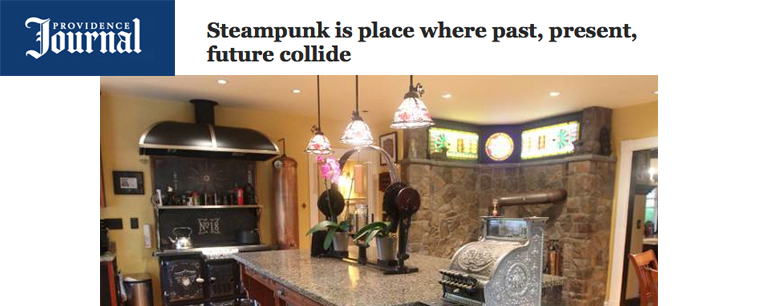

Imagine technological design inspired not by the sleek, minimalist aesthetic of, say, Apple, but by the Victorian age of industry and invention. Picture lots of brass, copper and iron, gears, valves, tubes, gauges and pipes, with everything powered by steam.
That’s steampunk, which started out in the literary world as a subgenre of science fiction and has since evolved to include furniture, sculpture, fashion, jewelry, film, TV, music and art. Think of it as a place where past, present and future collide.
Bruce Rosenbaum and his wife, Melanie, have a design company called ModVic, which stands for Modern Victorian, and own a 1901 “steampunk house” in Sharon, Mass. (The house is currently for sale.)
“It’s a re-imagination of history,” he said of steampunk. “What if the Victorian age and the digital age had merged?”
When he’s designing a steampunk artifact, Rosenbaum said, he thinks of the acronym HAT, which stands for history, art and technology.
“I take it as a way to creatively problem solve. Putting opposites together, and synthesizing them to create something new,” Rosenbaum said. “When people see the old and new together, their brains do a ‘What’s that?’ It becomes very attractive.”
Rosenbaum, 52, said he discovered steampunk when he and his wife were renovating their house, which they bought in 2000. Some friends came over and told the Rosenbaums they were “steampunking.” He had never heard the phrase before, so he started looking into it.
Before too long, Rosenbaum, who owns a direct marketing business, had also become a steampunk designer.
His office in the steampunk house includes a computer station made from a Victorian pump organ. “It was such a beautiful piece of furniture. It was just calling for me to restore it,” he said.
The office also features an old time clock from the International Time Recording Co., the precursor to IBM, a phone taken off an old battleship, and a 19th-century ship’s binnacle. The closet door has a big bronze ship’s valve, a porthole and a small plaque reading “Beware Steam Fanatic.”
In the kitchen, there’s a massive black wood-burning stove, but equipped with a modern stovetop. The house has an entertainment center made from an old fireplace mantel, with the flat-screen TV located where the mirror would have gone.
In addition to his own house, Rosenbaum does commissions for private and corporate clients, such as the 6-foot mechanical whale he made for a hotel in Nantucket or an office full of steampunk furniture for a Boston attorney. He’s working on projects for Hershey’s chocolate and Pabst Blue Ribbon Beer.
Rosenbaum said he finds pieces at antique shows, such as the ones at Brimfield, Mass., or at architectural salvage companies. He’ll come up with an idea, and then hire electricians or metalworkers to help bring it to life.
In Providence, steampunk comes to the Lippitt House Museum next Saturday, Oct. 18, at the Steampunk Mansion Mashup, which will feature musicians, performers, and artists.
Carrie Taylor, director of the Lippitt House Museum, said it’s part of the museum’s efforts to open the house to new audiences.
Taylor said the Lippitt House, completed in 1865, and steampunk make a good match. The house itself is a treasure trove of Victorian design, with stained-glass windows and ornate woodwork.
Henry Lippitt, its builder, was a man of the industrial age, with interests in textile manufacturing and railroads. For its time, the house was technologically advanced, equipped with running water and central heating.
The Mansion Mashup is presented by the Lippitt House in association with the Red Fork Empire, a collaborative group of steampunk enthusiasts.
Emperor of the Red Fork Empire, Justin Stanley, said he was contacted by Taylor about holding an event at Lippitt House.
“When I walked into the Lippitt House, I was blown away,” he said. “I thought, we should definitely be here. Steampunk is all about history — albeit alternative history — and the whole decor at the Lippitt House works perfectly.”
The “red fork” comes from a children’s story Stanley wrote in which the fork is a symbol for imagination and creativity.
He discovered steampunk when he began attending comic book conventions, wearing a blue suit with big red cravat, circular wire-rim glasses and a huge metallic robot fist that Stanley calls “the will of the people.”
“People came up to me and said ‘We love your steampunk outfit.’ I had no idea what they were talking about,” Stanley said.
So he did a little research into steampunk.
“I loved the aesthetics of it, I loved the way it looked,” he said. “Unknowingly, I was dressing the part.”
The Lippitt House event will include steampunk lamps designed by Glenn Webber of North Kingstown.
Some use profusions of bulbs, metal arms, gauges and gears. One has what resembles a bat’s wing sheltering a cylindrical part that houses the bulb.
“Old mechanical devices have always interested me,” Webber said. “I like recycling stuff, and putting a different slant on it. . . . I find parts at flea markets, and find creative ways to put them together. The more I do it, the more I like to do it.”
